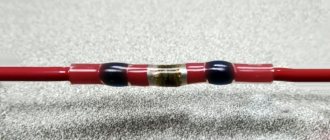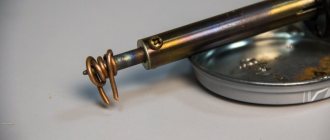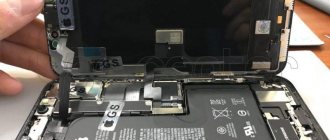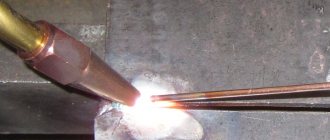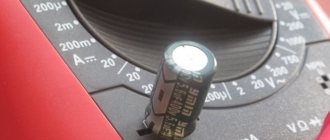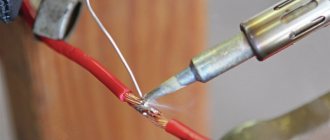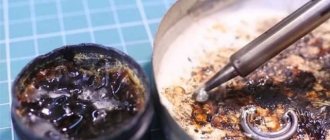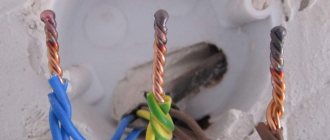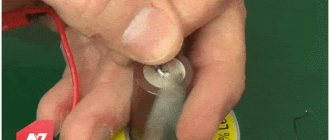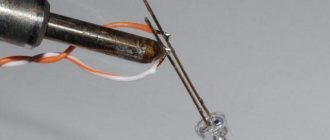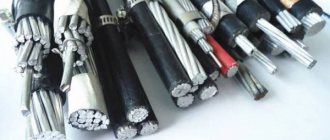Features of soldering aluminum at home
Aluminum is a lightweight, durable metal used in industrial, household, technical industries and electronics. There is an opinion that it can only be soldered using special equipment, and such an operation is impossible in everyday life. But many users have encountered situations where they need to create an airtight connection (for example, sealing a pan). This possibility exists and soldering aluminum at home is a reality. You just need to know the technology and have certain elements on hand.
Which is better: welding or soldering aluminum
It’s impossible to say unequivocally that welding or soldering aluminum is better. It depends on the purpose of the parts and the professionalism of the person. For an experienced welder, welding is naturally a more acceptable option, while soldering is more suitable for a craftsman with a soldering iron.
If it is necessary to repair the radiator, it is better to use soldering, since it is much cheaper, and welding is more suitable for carrying out more critical work.
Soldering aluminum is a complicated process, but you can do it yourself at home. However, carrying out work without the use of special materials does not guarantee high-quality adhesion of parts. This will only lead to wasted time and effort. Therefore, you need to immediately prepare for the procedure in order to carry it out efficiently and quickly.
Information on aluminum soldering techniques
The ability of a metal to create a strong oxide film on its surface is a major problem in soldering. It cannot be removed mechanically by stripping, since the process of forming a new film takes less than a second. Such an obstacle does not allow tinning of the surface, because it is refractory, and the base material (aluminum) has a melting point of 660 (alloys are even lower).
To solve the problem, it is necessary to use special fluxes and solders. It may be necessary to additionally heat the surface on a gas stove or with a blowtorch.
DIY aluminum soldering can be done using a conventional soldering iron with a power of 100 watts or more or a gas torch. The second option is used when processing large areas and long joints. But the main part must not be allowed to overheat, because it may melt or become deformed (change in geometry).
Solder for soldering aluminum
Solder for soldering aluminum is made from zinc or aluminum. Additives are added to it to achieve various characteristics: to lower the melting point and increase strength. They are produced in America, Germany, France, Russia. Let's look at some of them.
A common and widely advertised solder for aluminum is HTS 2000. It is produced by a company from the USA. Practice shows its fragility: soldered parts allow air and moisture to pass through. It cannot be used without flux.
Castolin 192FBK based on zinc (97%) and aluminum (2%) is produced in France. The Castolin company produces solders 1827 and AluFlam-190, intended for soldering copper and aluminum at 280°C.
Castolin 192FBK is a tubular solder containing flux in the core. It is produced in the form of rods, 100 g of which costs 100-150 rubles. Solders small holes and cracks well.
Chemet Aluminum 13 is a solder used when welding parts at 640°C and above. It is based on aluminum (87%) and silicon (13%). The melting point of solder is about 600°C. It is produced in the form of rods, of which there are 25 pieces per 100 g. 100 g cost 500 rubles. The variety called Chemet Aluminum 13-UF has a hollow structure and contains flux in the core. Its cost for 12 rods, which weigh 100 g, is 700 rubles.
Aluminum solder is also produced at domestic enterprises. For soldering using a gas torch, grade 34A is used. It melts at a temperature of 525°C and solders AMts, AM3M, AMg2 alloys well. 100 g cost 700 rubles.
Grade A consists of 60% zinc, 36% tin and 2% copper. Melts at 425°C. Produced in rods weighing 145 g. The cost of one rod is 400 rubles.
SUPER A+ is produced in Novosibirsk and is an analogue of HTS-2000. Used together with SUPER FA flux. Costs 800 rubles. per 100 g. In the molten state it becomes viscous, you have to use steel tools to level it.
Functions performed by flux
In order for aluminum or its alloy to interact with the solder, it is necessary to destroy the film on its surface at the site of the future connection. This function is performed by flux, a substance capable of:
- remove oxide formations;
- normalize the surface tension of the metal;
- improve solder distribution.
When choosing a flux, you must carefully study the attached annotation. It indicates what metal the product is intended for and the type of solder with which it interacts most effectively.
Among the domestically produced active fluxes for do-it-yourself aluminum soldering, the following brands are recommended:
- F 61 – when working with aluminum alloys and in low temperature conditions.
- F 64 – for large and massive parts.
- F 34A - when using refractory solders that require high temperatures.
A foreign analogue that is popular in our country is Castolin Alutin 51L. The greatest efficiency is achieved when interacting with solders from the same company.
Solder, its purpose and selection criteria
Solder is a material used to join metal parts or workpieces, as well as to restore surface integrity. Its melting point is lower than that of aluminum and is divided into:
- low;
- average;
- high.
Compositions operating at medium and high temperatures have received the main recognition, because the compounds created on their basis are distinguished by their strength and durability. Low-temperature solders can be destroyed when the product overheats, so they are used for soldering objects that do not require significant heating.
Compositions containing components such as silicon, copper, aluminum, zinc are most suitable for soldering aluminum. Among them are TsOP-40, 34A or imported Aluminum 13.
The strength of the connection and its resistance to corrosion is directly dependent on the percentage of zinc in the solder.
Features and principles of soldering
The low temperature value of metal melting complicates the technological process of soldering, as well as repairing products with your own hands. Parts very quickly lose strength when heated, and structures reduce stability when the temperature reaches 300 degrees. Low-melting solders consisting of bismuth, cadmium, indium, and tin come into difficult contact with aluminum and do not provide sufficient strength. Excellent solubility is observed in the metal in combination with zinc, which makes the soldered areas highly reliable.
Preparatory stage
Before starting the actual process of soldering aluminum, it is necessary to prepare the workplace, tools and the material itself:
- Preparing the workplace comes down to removing unnecessary items, especially when using a gas torch or blowtorch.
- The workpieces must be securely fastened in yews or clamps.
- Tools are located in easily accessible places at arm's length.
- Solder must be prepared in sufficient quantities to prevent interruption of the soldering process to find and deliver it.
- Aluminum blanks in the soldering areas are cleaned with sandpaper or a file, and then degreased with acetone or gasoline.
- When working with large parts, the joints will have to be heated using an open fire, so special attention should be paid to observing fire safety measures.
Aluminum soldering process
After preparation, work begins on the direct soldering of parts. The procedure for soldering aluminum with a soldering iron is as follows:
- the soldering zone is abundantly covered with flux;
- the hot soldering iron tip is cleaned by immersing it in rosin;
- part of the solder is applied in a thin layer to the joint (tinning);
- the main layer of solder is applied.
After final hardening, the treatment area is wiped with a damp sponge and sanded with a tool with an abrasive surface.
Soldering aluminum with a gas torch occurs somewhat differently. The workpieces must be heated over the entire surface, otherwise an effective connection cannot be achieved. Wire solder is used, melted by the flame of a gas burner directly at the junction of the parts. The joint is first treated with flux.
Aluminum soldering torches
You need to know how to solder with a gas torch. If the area of the parts is large and there is not enough soldering iron power, use a torch. It is better to use a gas one, since soldering aluminum with a gas torch has great capabilities. The burner quickly heats the joint of the parts almost to the melting temperature of aluminum. Flux with solder is applied to the joint, leveled with a soldering iron tip and hardened. The joint must be washed to remove any remaining soldering acid or other flux.
When working with burners, you must follow fire safety rules. There should be no flammable liquids or materials nearby.
Soldering aluminum with a soldering iron and gas torch
There is a widespread belief that it is impossible to solder or tin aluminum (as well as alloys based on it) without special equipment for this.
Two factors are cited as an argument:
- upon contact with air, a chemically resistant and refractory oxide film (AL2O3) is formed on the surface of the aluminum part, resulting in an obstacle to the tinning process;
- The soldering process is significantly complicated by the fact that aluminum melts at a temperature of 660°C (for alloys this ranges from 500 to 640°C). In addition, the metal loses strength when, during the heating process, its temperature rises to 300°C (for alloys up to 250°C), which can cause a violation of the stability of aluminum structures.
Considering the above factors, it is truly impossible to solder aluminum using conventional means. The use of strong fluxes in combination with the use of special solders will help solve the problem. Let us consider these materials in detail.
Soldering aluminum with a gas torch
Aluminum is a rather capricious material for soldering. Many home craftsmen who first tried to solder
As a rule, nothing works out between two aluminum parts, and they abandon this idea.
And all because this metal oxidizes quite quickly when interacting with air (almost immediately after cleaning the surface, an oxide film is formed), and the solder
it simply rolls into a ball.
Therefore, soldering aluminum at home
few people do it seriously - due to the ineffectiveness of this process.
But there are no hopeless situations - you can always find a solution to this or that problem.
The purpose of this article is to talk about some of the nuances, as well as share with readers useful tips on how to solder aluminum at home
so that everything works out, if not the first time, then definitely the second time.
One of the important conditions for successful soldering of aluminum is a very tight fit of the parts - the gap between them should be minimal so that the solder does not leak anywhere. This does not apply to cases where it is necessary to solder a through crack.
Another important point that you need to pay attention to is the temperature of the metal surface.
It is necessary to heat the surface so as not to overheat the part (aluminum begins to melt at temperatures from 650 degrees Celsius), but at the same time so that the temperature is sufficient for the solder to work.
Optimal heating of aluminum
parts up to a temperature of 500 degrees. To determine the temperature of the metal, you can use a multimeter with a thermocouple.
Burner selection
To solder aluminum in a garage or home workshop, a tourist gas canister with a gas burner is most often used.
As a rule, a gas burner is purchased separately from the cylinder, and here it is extremely important not to make a mistake.
The fact is that a torch with a wide nozzle for soldering aluminum tubes
or other parts will not work, because it heats up a large surface area, whereas we only need local heating - specifically at the soldering site.
Therefore, it is best to use a gas torch with a narrow nozzle (for example, you can purchase a torch for soldering copper). You can see what it looks like in the photo below.
Soldering with Chinese rod
One way to solder aluminum is to use special solder. For example, Chinese. You can use Castolin 192 or HTS2000 solder.
The rod is a solid zinc tube that is filled with powdered flux. The latter is precisely what is needed to “dissolve” the oxide film on the surface of the aluminum.
According to the manufacturer, using this solder you can solder aluminum parts with high quality, without even needing to clean the surface to get rid of the oxide film.
The soldering method is very simple. We press the parts together as tightly as possible (in this case, these are aluminum plates) so that there are no large gaps.
After this, we heat the joint to a temperature of 500 degrees Celsius using a gas burner. When the solder fills the gap between the parts and forms a seam, stop heating.
In exactly the same way you can solder
tubes
between each other (joint to joint or at an angle), and you can also solder other parts from different metals
to aluminum
.
In general, the Chinese solder (despite the fact that it is Chinese) coped with its task. Since solder has good fluidity and perfectly fills any cracks and grooves, it can be used for soldering car radiators.
For details on how to solder aluminum using special solder, see the video below. The author of the YouTube channel voltNik shared his experience.
ALUMINUM SOLDERING. NO ARGON NEEDED!
Method with a brush attachment for metal
If it is not possible
buy a Chinese rod, there is a simple way to
solder aluminum with tin
.
This method is also suitable for soldering duralumin
(aluminum
alloy
).
To do this, we need a gas can with a torch, a tin stick and a screwdriver or electric drill with a wire brush for metal to clean the surface of the aluminum part before soldering.
Many people are interested in how to solder
through hole in a part. It's time to cover this topic.
Let's look at this method using a specific example - in our case, it is necessary to solder a cut on the fender of a car.
The first step is to clean and tin the aluminum surface.
First, we heat the aluminum surface using a gas burner and apply a small amount of tin. It will immediately roll into balls, but that’s okay - that’s how it’s intended.
Next, we heat the aluminum surface again using a burner, and at the same time clean it with a brush attachment.
Add a little more tin as needed to create an even layer
. After this, you can proceed directly to the soldering itself.
When the aluminum has completely cooled, it will be necessary to treat the soldering area with an angle grinder (grinder). To level the surface perfectly, you will need to use fine sandpaper.
You can see more details about this method of soldering aluminum in the author's video below. The author of the YouTube channel “AS MASTER car repair in Omsk” shared his experience.
how to solder aluminum with tin
Solder
Commonly used low-melting solder bases are tin (Sn), lead (Pb), cadmium (Cd), bismuth (Bi) and zinc (Zn). The problem is that aluminum is practically insoluble in these metals (with the exception of zinc), which makes the connection unreliable.
By using a flux with high activity and properly treating the joints, you can use tin-lead solder, but it is better to avoid such a solution. Moreover, a solder joint based on the Sn-Pb system has low corrosion resistance. Applying a paint coating to the soldering area allows you to get rid of this drawback.
For soldering aluminum parts, it is advisable to use solder based on silicon, copper, aluminum, silver or zinc. For example 34A, which consists of aluminum (66%), copper (28%) and silicon (6%), or the more common TsOP-40 (Sn - 60%, Zn - 40%).
Domestic solder – TsOP-40
Note that the higher the percentage of zinc in the solder, the stronger the connection and the higher its resistance to corrosion.
High-temperature solder is considered to be solder consisting of metals such as copper, silicon and aluminum. For example, like the above-mentioned domestic solder 34A, or its foreign analogue “Aluminium-13”, which contains 87% aluminum and 13% silicon, which allows soldering at temperatures from 590 to 600°C.
"Aluminum-13" produced by Chemet
When choosing a flux, it is necessary to take into account that not all of them can be active towards aluminum. We can recommend using products from a domestic manufacturer for such purposes - F-59A, F-61A, F-64, they consist of ammonium fluoroborates with the addition of triethanolamine. As a rule, the bottle is marked “for aluminum” or “for aluminum soldering.”
Domestic flux
For high-temperature soldering, you should purchase flux produced under the brand 34A. It consists of potassium chloride (50%), lithium chloride (32%), sodium fluoride (10%) and zinc chloride (8%). This composition is most optimal if high-temperature soldering is performed.
Recommended flux for packing at high temperatures
Special solders
The highest quality connection at home can be obtained using low-melting solders based on tin and copper and special fluxes. The most popular domestic flux is F64, which allows you to solder aluminum parts without mechanical stripping. So, for example, soldering aluminum to copper can be done without problems, or an aluminum tube can be sealed from the inside, which cannot be cleaned by any other means.
In this case, conventional low-melting tin-lead solders with a melting point of 200−350 degrees are used. The soldering iron should be quite powerful - from 100 W and above. The reason is the high thermal conductivity of aluminum. An insufficiently powerful soldering iron simply will not be able to heat the soldering area to the melting temperature of the solder. Only very small parts (mainly in radio electronics) can be connected with a 60 W soldering iron.
A soldering iron is not suitable for soldering large aluminum parts. Here it is better to use any gas burner that provides heating up to 500-600 degrees, and one of the specialized solders. One of the most popular is HTS-2000 - a flux-free solder for soldering aluminum, copper, zinc and even titanium.
Read also: How to measure the internal diameter
It has several advantages:
- Low melting point (390 degrees Celsius).
- Can be used without flux.
- Reliability of the connection (in many cases it can replace argon welding).
True, HTS-2000 does not exclude the stripping process. Moreover, during the soldering process it is necessary to remove the oxide film with a solder rod or a wire brush to ensure a reliable connection. However, this method allows you to perform such work as sealing leaky aluminum containers, for example, cans, or even car aluminum radiators.
In addition, HTS-2000 is practically the only (with the exception of argon) way of joining two “winged” metals: aluminum and titanium.
There are other high temperature solders designed specifically for aluminum soldering. For example, 34A, which contains two-thirds aluminum, as well as copper and silicon. But the melting point of such solders is 500-600 degrees Celsius, which is close to the melting point of aluminum itself.
Therefore, using high-temperature solders at home is dangerous - an aluminum part can be irreparably damaged when heated to such high temperatures.
Soldering aluminum at home is a real way to repair household utensils, household and automobile aluminum radiators, pipes, plumbing fixtures and much more. In industrial conditions, soldering and welding of parts made of this material is carried out using automated equipment. At home, soldering and welding aluminum is also possible.
To do this, use an ordinary soldering iron, ordinary POS-50 and POS-61 solders containing tin. In addition, it is possible to use a magnesium welding stick or use a gas torch.
Once you have chosen your solder, you need to select a soldering flux. The biggest secret when soldering aluminum is to work quickly , connecting the parts to be soldered immediately after they have been cleaned of oxide.
Surface preparation
Before you begin tinning, you must complete the following steps:
- degrease the surface using acetone, gasoline or any other solvent;
- remove the oxide film from the place where soldering will be performed. For cleaning, use sandpaper, an abrasive wheel or a brush with steel wire bristles. As an alternative, etching can be used, but this procedure is not so common due to its specificity.
It should be taken into account that it will not be possible to completely remove the oxide film, since a new formation will immediately appear in the cleaned area. Therefore, stripping is carried out not with the goal of completely removing the film, but to reduce its thickness in order to simplify the task of the flux.
Heating the soldering area
To solder small parts, you can use a soldering iron with a power of at least 100W. Massive items will require a more powerful heating tool.
Soldering iron 300 Watt
The best option for heating is to use a gas burner or blowtorch.
Simple gas burner
When using a burner as a heating tool, the following nuances should be taken into account:
- Do not overheat the base metal, as it may melt. Therefore, it is necessary to regularly monitor the temperature during the process. This can be done by touching the solder to the heated element. Melting the solder will let you know that the required temperature has been reached;
- Oxygen should not be used to enrich the gas mixture, since it promotes strong oxidation of the metal surface.
Preparation for soldering aluminum parts
At the preparation stage, it is necessary to carry out high-quality cleaning of surfaces from paint, if any, and dirt. Then you should degrease the parts with gasoline, acetone or another suitable solvent.
You should also be sure to remove the oxide film that always appears on the surface of the metal after contact with air.
Important! Without preliminary preparation for soldering, it will not be possible to achieve high-quality adhesion between parts.
How to remove oxide film
You can remove the oxide film from aluminum at home mechanically. To do this, it is recommended to use an angle grinder, a metal brush, sandpaper, and a special mesh made of stainless wire.
You can also clean it chemically using acid. But at home it is used extremely rarely.
Important! After removal, the oxide film will not completely disappear, but will become much thinner, which will allow for high-quality soldering.
Soldering instructions
The process of soldering aluminum parts does not have its own distinctive features; it is carried out in the same way as with steel or copper.
The algorithm of actions is as follows:
- the soldering area is degreased and cleaned;
- the parts are fixed in the desired position;
- the connection area heats up;
- touch the solder rod (containing active flux) to the joint. If flux-free solder is used, then flux is applied to destroy the oxide film, after which a solid piece of solder is rubbed over the soldering area.
A brush with steel wire bristles is also used to break down the aluminum oxide film. This simple tool is used to rub molten solder over an aluminum surface.
Soldering aluminum - complete video instructions https://www.youtube.com/watch?v=ESFInizLE9U
How to solder aluminum at home: solder for soldering, methods, features
The procedure for soldering aluminum elements at home is a very problematic process, which is facilitated by the use of special materials. The work is complicated by the immediate appearance of a thin oxide film at the stripping site, which interferes with soldering. An additional difficulty is created by the material itself, which has a low melting point (+660 °C). Using solder for soldering aluminum, special strong fluxes and following technology, you can independently solder almost any aluminum object.
Several excellent ways to solder aluminum and duralumin at home
Its advantages are significant, it is lightweight, and duralumin can generally be compared in hardness to steel. Moreover, duralumin is 3 times lighter than steel.
Electrical engineering widely uses aluminum.
After all, the electrical conductivity of pure aluminum is 62% of the conductivity of copper. Pure aluminum is used in the production of foil, which is often used for electrolytic capacitors.
But compared to copper, its price is lower.
Aluminum is the third most abundant and most common metal in the earth's crust, accounting for 8% of its mass. And suddenly there is a problem, soldering aluminum or at least tinning, radio amateurs know, this is also a terrible test of nerves and perseverance. After all, such soldering is a rather complex technological process to perform. So what's wrong with aluminum, why doesn't it want to tin?
That oxide doesn’t want to stick to our solder. Therefore, almost all efforts when soldering aluminum should be aimed at removing that oxide film, using any not prohibited methods.
Method 1. Soldering with a file or sandpaper:
The soldering area here should also be permanently in that sawdust rosin. As you might guess, the sawdust here scratches the oxide, and as a result, solder sticks to it.
Method 3. Analgin for soldering:
Method 4. Machine oil (for sewing machines or precision mechanisms, liquid):
Soldering in mineral (machine) oil using abrasive tools can give good results. The same iron filings, a knife or a dental drill.
If the part thickness is more than 2 mm, the part must be warmed up before applying oil. But be careful, not forgetting that applying oil to a hot surface can cause splashes. Solder must contain at least 50% tin. The best results are obtained when using alkaline oil to clean the weapon after shooting.
Method 5. Special fluxes for soldering aluminum:
Method 6. Vacuum soldering:
If possible, soldering aluminum in a vacuum chamber gives good results. But here, preliminary cleaning of the surface of the part is also necessary.
Soldering and welding in space in general, as some astronauts say, is very high quality and durable.
Method 7. Copper plating of aluminum:
Using copper sulfate (CuSO4), you can create a galvanic installation for coating aluminum with copper and then tinning it.
It is interesting that aluminum welding is not possible for the same reasons - the formation of an oxide film on aluminum. Therefore, the inert gas argon is used for welding. Argon partially displaces the oxygen in the air. But still, when starting welding, the joints must be degreased and cleaned with abrasive tools, preferably under a stream of argon. Otherwise, the aluminum electrode, even with argon, when fed, will simply melt and curl into balls and not stick.
If anyone has their own methods for soldering aluminum, please share, it will be interesting.
Pros and cons of soldering
Soldering aluminum using a gas torch has a number of advantages. These include:
- Quality of work. Using a torch makes it possible to obtain a high-quality seam connecting metal parts to each other.
- Easy to use. Even a person who does not have any experience can heat surfaces with a gas burner.
- Versatility. The ability to adjust the flame intensity eliminates the need to use several soldering irons at the same time.
- Mobility. Unlike soldering aluminum with an electric soldering iron, there is no need to connect the equipment to a power source.
- Uniform heating. It is possible to heat the surfaces of workpieces simultaneously with flux and solder.
- Saving time on equipment preparation. Aluminum soldering can be done immediately after connecting the device to the gas cylinder.
Process technology during work execution
When soldering aluminum, an oxide film is formed on the surfaces of parts. If you perform soldering without first removing the oxide film, the seam will not have the necessary strength. The film forms on the metal surface very quickly, so it cannot be removed by mechanically cleaning the workpiece.
Torch angle during aluminum soldering
Specialized fluxes are used to remove the oxide film. They block the access of oxygen to the soldering site. Fluxes used when soldering aluminum contribute to the rapid melting of the filler wire and its better adhesion to the parts. It is possible to prepare the metal for soldering using chemicals. In this case, a solution is first prepared and applied to the workpieces.
After mechanical cleaning and chemical treatment of aluminum, the workpieces are heated to high temperatures. The degree of heating is regulated by the intensity of the flame. The filler wire is fed to the heated joint. Its temperature is lower than that of the metal being soldered. The solder melts and fills all the irregularities and micropores located on the surface. As the solder cools, it hardens, creating a strong weld.
Equipment and materials
To perform aluminum soldering work, certain equipment and consumables are required. The strength of the connection depends on the quality of the materials used for soldering. The devices and materials that will be needed during the work are listed below.
Gas-burner
One of the main devices during the process is a gas burner. Both a powerful device and a small device can be used. The device supplies gas under high pressure. The contents of the cylinder at the outlet of the device are mixed with air and ignite. By adjusting the pressure at the outlet of the device, you can set the required flame temperature.
The device heats metal surfaces. By exerting a temperature effect, the flame melts the filler wire and allows the solder to spread at the junction of the parts.
Portable multifunctional gas burner
Gas cylinder
A gas cylinder is a sealed container for storing gaseous substances. To carry out the process, you can use cylinders of various volumes. To avoid an explosion, the container should be installed at a safe distance from the work site.
Hose and clamps
A flexible rubber hose is used to supply the substance from the cylinder to the device. It must meet safety requirements. Do not use hoses that are not properly sealed, as this may result in leakage. The hose is attached to the burner and cylinder with specialized clamps.
Gearbox
To ensure safety during the process, it is necessary to connect the equipment to the cylinder through a reducer. It prevents flame backlash. The reducer is installed at the outlet of the cylinder, and is a mandatory device when connecting.
Propane reducer for gas burner
To obtain a high-quality connection, you should use a specialized flux. Its composition may vary depending on the type of work performed. This substance promotes rapid melting of the filler wire and cleans the surface of the oxide film.
Soldering flux
Filler wire (solder)
The solder used may vary depending on the type of work. The composition and diameter of the filler wire is determined based on the physical characteristics of the workpiece metal. When choosing solder, you should pay attention to its melting point. It should be lower than that of the metal part.
Means of protection
To avoid injury, personal protective equipment must be used. These include gloves and safety glasses. Gloves protect the operator's hands from burns. Safety glasses are used to protect the worker's eyes from small abrasive particles.
Materials used in the work
For high-quality aluminum soldering, specially selected fluxes and solders should be used. This will allow you to carry out quality work.
Fluxes for aluminum soldering
Flux is an auxiliary component that prevents the formation of an oxide film during soldering. Its function is also to ensure good wetting of the surface with liquid solder, which ensures reliable adhesion.
But in the absence of flux, it can be replaced with transformer oil, having previously cleaned the surfaces with sandpaper. This will slow down the process of formation of the oxide film.
The effect of flux depends on its composition
Rosin
This type of flux is the most popular. Rosin can be used for soldering any metals. But in the case of aluminum, the work must be performed without access to air, which significantly complicates its implementation. As a result, soldering takes longer and the efficiency is low.
Important! When using rosin, the quality of the aluminum connection is not particularly strong.
Powder flux
For soldering aluminum, you can use powder fluxes together with a gas torch. When carrying out work, oxygen should not be added to the flame, as this causes oxidation of aluminum.
The most common powder fluxes:
- borax (a mixture of sodium salt and boric acid);
- active flux F-34A (contains potassium, lithium, zinc chlorides and zinc chloride);
- acetylsalicylic acid;
- active solder fat.
Liquid flux
This type of flux can be applied to the surface in a thin layer. But at the same time, they evaporate much faster and are capable of releasing scalding vapors.
The most popular types:
- flux F-61—recommended for low-temperature soldering;
- flux F-64 - destroys even a fairly strong oxide film;
- Castolin Alutin 51 L - suitable for work at temperatures from 160 degrees.
Solder for soldering aluminum and its alloys
To solder this metal, it is recommended to use solders made from materials such as aluminum and zinc. Moreover, they can contain various additives, which improves their functionality.
The most popular imported solders for aluminum:
- HTS-2000;
- Castolin 192FBK;
- Castolin 1827;
- Chemet Aluminum 13;
- Chemet Aluminum 13-UF.
Important! The solder must wet the surfaces of the parts well, otherwise high-quality soldering will not be possible.
Domestic solders and their quality
Domestic solders can also be used to work with aluminum parts at home. They are not inferior in efficiency to imported ones, but are much cheaper.
The most popular of them:
- POS-61;
- grade A;
- 34A;
- SUPER A+.
Comparison of solders for aluminum soldering
When comparing imported solders HTS-2000 with Castolin 192fbk, as well as domestic “aluminum cucumber”, many professionals note that the latter has high soldering strength, since it consists of aluminum. But its disadvantage is that the work must be carried out in the oven.
As for HTS-2000, the reviews are mostly negative, since the solder has a viscous consistency and you should use steel tools to level it on the surface.
Castolyn 192FBK is also characterized by high fluidity. It is ideal for soldering small holes, but when used for large holes it can fall inside aluminum parts.
When choosing solder, you need to consider the soldering mode
Cored wire
This material can only be used when welding aluminum, not soldering. Therefore, these two completely different types of work on connecting parts should not be confused. The use of flux-cored wire makes it possible to weld without gas.
Heating sources
To properly solder parts, you need not only to know what fluxes and solders can be used, but also how to solder aluminum at home with a soldering iron, using different heat sources.
Soldering iron for soldering aluminum
When using a soldering iron, you need to consider the size of the parts to be connected. The amount of heat from the source must be greater than it will be dissipated. Approximately 1 thousand sq. cm of aluminum dissipates about 50 W of thermal power. This means that to solder parts with such a total area, you need to use a soldering iron with a power of 90-100 W.
Aluminum soldering torches
If you need to solder thick aluminum sheets, it is better to use gas torches. The advantage of such a source is that it delivers heat without contact and is characterized by a high heating rate.
Important! When using a torch, the parts may not even have time to heat up before they are already soldered.
Preparation and execution of the process
Preparation of blanks
Before starting the process, the soldering areas must be cleaned of dirt, oxidation and other foreign deposits. This can be done mechanically using sandpaper or a wire brush. Then, using specialized chemical compounds, the material is cleaned of fatty deposits and oxide film. Acetone or solvent can be used as a cleaner.
Restoring parts by soldering
Soldering
The first step when soldering parts is to apply flux to the joints. Then, using a gas burner, the workpieces are heated to the required temperature. The degree of heating must be such that the filler wire can be melted to a liquid state.
Solder is applied to the heated parts. It should completely melt and spread, filling all the irregularities and pores on the surfaces. If necessary, several stitches are applied. After the solder has spread, the parts should be allowed to cool completely. The cooled connection is suitable for use.
Soldering an aluminum pipe with a gas torch
So, soldering is one of the ways to connect aluminum parts. With proper preparation of the surfaces of the workpieces and compliance with technological requirements, this method allows you to obtain a high-strength seam using a minimum amount of equipment. Thus, the soldering process can be carried out without difficulty at home.
